Don’t panic – it’s in the box
When the bite turns tough, turn to your tried-and-true baits
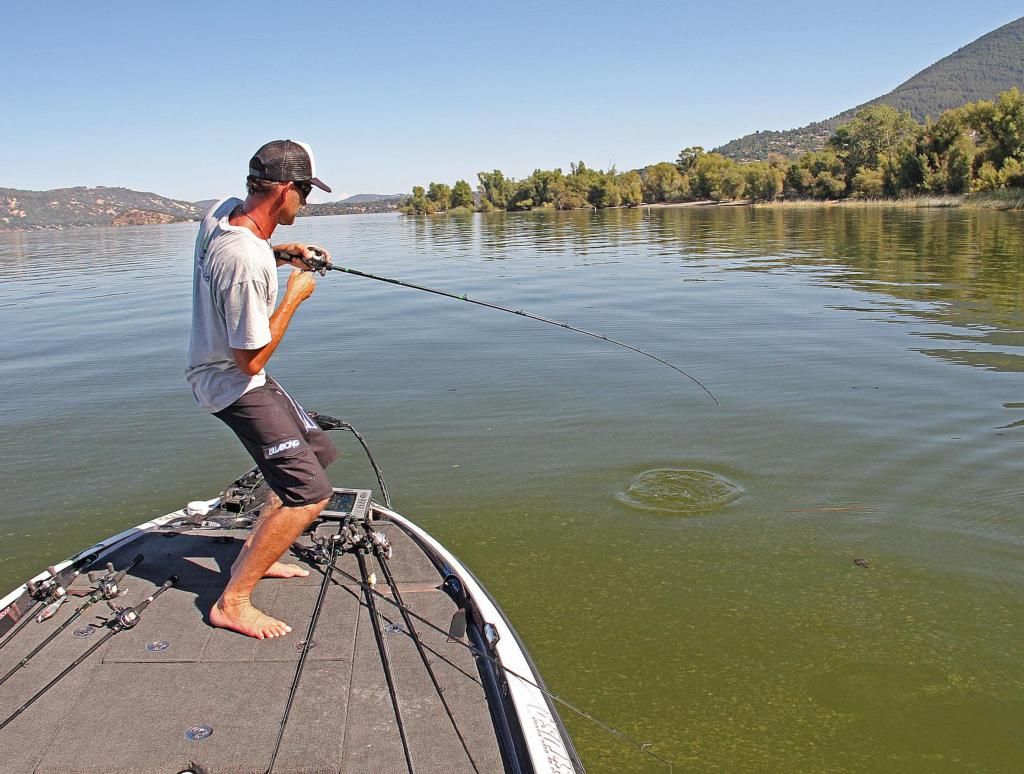
When daylight’s fading, or tournament time’s expiring, fishermen desperate for a bite often fall back to a handful of tried-and-true baits in which their confidence rests. It may be some old-time favorites or a lake-specific selection. In any case, the proverbial “panic box” can be the make-it-or-break-it element when anglers struggle.
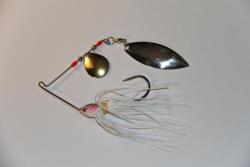 Texas EverStart pro Stephen Johnston starts us off with his one-two punch of surefire baits that take the panic out of practically any situation he faces. One’s about reaction while the other is all about finesse. Tough days will always find him reaching for either a 3/8-ounce spinnerbait with a small Colorado and willow blade combination or an 8-inch V&M straight-tail finesse worm wacky-rigged on a 2/0 hook.
Texas EverStart pro Stephen Johnston starts us off with his one-two punch of surefire baits that take the panic out of practically any situation he faces. One’s about reaction while the other is all about finesse. Tough days will always find him reaching for either a 3/8-ounce spinnerbait with a small Colorado and willow blade combination or an 8-inch V&M straight-tail finesse worm wacky-rigged on a 2/0 hook.
“I call that small spinnerbait ‘my limit getter’,” Johnston said. “That’s one bait I feel like I can always pick up and catch a big fish. From Texas to Florida, Carolina to Arkansas, I’ve caught some monster sacks on that bait.
“I think the small profile is what makes it effective. No matter what lake you’re on a bass always eats a small bream or shad. Whether you’re around grass, rocks, docks, whatever, you will catch a bass on a small spinnerbait.”
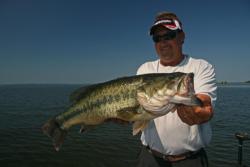 Favoring 7- to 10-pound fluorocarbon line for the wacky worm (6-pound for clear northern lakes), Johnston depends on this simple rig for a wide range of scenarios in which bass play hard-to-get. From bed fish, to those guarding fry, to bass suspending in 12-plus feet of water, the wacky attack seldom lets him down.
Favoring 7- to 10-pound fluorocarbon line for the wacky worm (6-pound for clear northern lakes), Johnston depends on this simple rig for a wide range of scenarios in which bass play hard-to-get. From bed fish, to those guarding fry, to bass suspending in 12-plus feet of water, the wacky attack seldom lets him down.
“That worm doesn’t do anything – it just falls in front of those fish and they just have to eat it,” Johnston said. “It’s kind of like force feeding them. They’re sitting there in a `blah’ mood; no chasing, no feeding and you keep dropping that worm in front of their face. They’re going to eat it.”
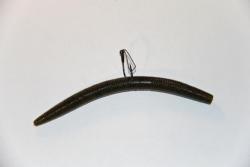 Case in point: In early January 2008 Johnston caught 23 pounds, 7 ounces on day one of the EverStart Texas Division event on Falcon Lake, but saw day two take a painfully lean turn. A trip to the panic box eventually yielded a top-10 finish.
Case in point: In early January 2008 Johnston caught 23 pounds, 7 ounces on day one of the EverStart Texas Division event on Falcon Lake, but saw day two take a painfully lean turn. A trip to the panic box eventually yielded a top-10 finish.
“The second day at 11 o’clock I did not have a keeper,” he recalled. “I put everything down, picked up my wacky rig rod and it just at an hour, I had 25-11.”
A peak at the pros’ `panic’ baits
Not everyone admits to keeping a panic box. Some go all-out every day and take a live-or-die approach to their game plans. Conversely, experience has taught many the value of formulating a specific plan those goes much deeper than the concept of “fallback” baits. Here’s a glimpse at some of those plans.
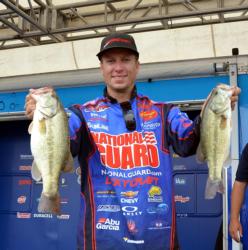 Brent Ehrler (Redlands, Calif.): The FLW Tour pro and 2006 Forrest Wood Cup champion said his “panic” baits are synonymous with his top confidence baits. He’ll keep 10 bags of Yamamoto Senkos and Kut Tail worms in a zippered Plano speed bag with Picasso Shakedown shaky heads (1/16-ounce to ¼-ounce) and 1/0 Owner Weedless Wacky Hooks in a small Plano box, and pack a Plano 3730 full with Lucky Craft LC 1.5 crankbaits.
Brent Ehrler (Redlands, Calif.): The FLW Tour pro and 2006 Forrest Wood Cup champion said his “panic” baits are synonymous with his top confidence baits. He’ll keep 10 bags of Yamamoto Senkos and Kut Tail worms in a zippered Plano speed bag with Picasso Shakedown shaky heads (1/16-ounce to ¼-ounce) and 1/0 Owner Weedless Wacky Hooks in a small Plano box, and pack a Plano 3730 full with Lucky Craft LC 1.5 crankbaits.
A master of time management, Ehrler points to the timeless wisdom of the KISS principle – “Keep It Simple Stupid.” No sense deliberating over a dozen colors when the moment demands decisiveness. He goes with all natural colors – watermelon and green pumpkin for the worms; shad and crawdad colors on the cranks.
“Both (the worms and crankbait) get a lot of attention,” Ehrler said. “This varies from lake to lake and there are weather variables as well. If it’s dead calm and tough fishing, the shaky head and wacky rig Senko get the most attention. If the weather gets nasty (windy and/or rainy) this is when the LC 1.5s plays a big role. I feel like any lake I go to in any state at any time of year, I can catch fish on these baits.”
That’s especially valuable when a sudden change in conditions drastically affects his pattern. Example: On the 2011 FLW Tour, Ehrler was flipping shoreline brush on the Red River 2011. However, when the water dropped the fish scattered. Rather than panic, he pulled out the Luckycraft 1.5 DRS and cranked his way to a sixth-place finish.
Matt Newman (Agoura Hills, Calif.): When the going gets tough, Newman has his own fallback selections: a shad or chartreuse float-and-fly rig, a Rooster Tail and several 3-inch Roboworm Alive Shads with No. 4 light wire hooks for a finesse Carolina rig. The Rooster Tail gets the call in many panic situations, but for Newman’s real nightmare moments, nothing delivers as dependably as a light Carolina rig comprised of a 6-pound leader and a 3/16- to ¼-ounce bullet weight sliding above the swivel connecting to 8- or 10-pound main line. The light hook allows the bait to float up and a patient presentation often yields much needed results.
“I feel that if we are finesse fishing, the fish shouldn’t be able to detect weight,” Newman said. “With my rig they pull on the bait, which slides through the weight, and that lets me know right away I have a shopper. The big difference between my way and (traditional) Carolina rigging is the way I fish it. With a C- rig, you are usually always moving the bait. My way, I barley inch it along the bottom, stopping it for 30 seconds or so. It’s a very, very slow retrieve.”
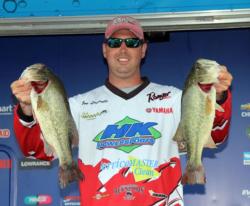 Joe Lucarelli (Center Harbor, N.H.): The natural lake smallmouth specialist bases his panic box selection on three criteria. First is color. The tougher the bite, the more he will use natural and translucent looking baits. The next group comprises shape and do-nothing baits like the Xzone Slammer and Yamamoto Shad Shape Worm. While those baits convey a nondescript charm, they work wonders on stubborn smallies. However, f all else fails, he resorts to a brash, yet effective panic move based on profile.
Joe Lucarelli (Center Harbor, N.H.): The natural lake smallmouth specialist bases his panic box selection on three criteria. First is color. The tougher the bite, the more he will use natural and translucent looking baits. The next group comprises shape and do-nothing baits like the Xzone Slammer and Yamamoto Shad Shape Worm. While those baits convey a nondescript charm, they work wonders on stubborn smallies. However, f all else fails, he resorts to a brash, yet effective panic move based on profile.
“When it gets super tough and I am getting ready to lose it, I will increase the size of my baits to try and get a fish to react,” Lucarelli said. “If I’m throwing a 6-inch Yamamoto lizard on a Carolina rig, I will go to an 8-inch lizard and scare them into biting. Or if I’m catching fish on a Luckycraft Pointer 100 jerkbait and they will only look at it or just bump it, it’s time for the big boy 128 Pointer.”
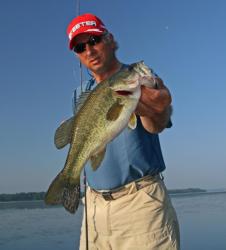 Steve Chaconas (Alexandria, Va .): For the Potomac River guide, client skill level can be every bit as challenging as weather woes and crowded waters. Therefore, Chaconas built his panic plan on tactics that practically anyone can handle. He calls his top choice the “shawacky rig” – a blending of shaky head and wacky techniques. Starting with a 2/0 red Mustad weedless wacky hook, he squeezes a 3/16-ounce bullet shaped split shot onto the 20-pound Gamma fluorocarbon leader tied to his 20-pound braid. This combination of terminal tackle enables him to rig a Senko or Mann’s trick worm wacky style, but fish it like a shaky head.
Steve Chaconas (Alexandria, Va .): For the Potomac River guide, client skill level can be every bit as challenging as weather woes and crowded waters. Therefore, Chaconas built his panic plan on tactics that practically anyone can handle. He calls his top choice the “shawacky rig” – a blending of shaky head and wacky techniques. Starting with a 2/0 red Mustad weedless wacky hook, he squeezes a 3/16-ounce bullet shaped split shot onto the 20-pound Gamma fluorocarbon leader tied to his 20-pound braid. This combination of terminal tackle enables him to rig a Senko or Mann’s trick worm wacky style, but fish it like a shaky head.
Another creative rig places a 2/0 red Mustad octopus hook about an inch from the nose on a Senko’s skinny end and a homemade peg weight in the fat end. Thus arranged, the lead weight allows the hook end to stand up and shake. Notably, Chaconas fashions his weights from 1/4-ounce grub jig heads that he pours without hooks. He dips the round end in the hot lead and taps it on a board to flatten. The barb on the weight holds it tightly to the worm.
“For both of these rigs, the basic element for success is that casting accuracy is not important, and less is more as far as presentation,” he said. “Not only does this work for inexperienced clients, but also under tough tournament conditions to get reluctant pressured fish to bite.”
Don’t over think the situation
Whatever the vexation, if you’re thinking panic box, it’s high time to stop thinking and just fish. If that sounds oversimplified, it’s not. Consider the multiple layers of analysis, experimentation and exasperation you will have endured. How many “this-will-get-them” options will have flamed out by this point? How many sure-bet money holes will have shown a serious need for overdraft protection?
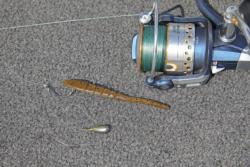 “I would not get more than three panic baits because if you do, you start thinking too much,” Johnston said. “You want something you can fish shallow and something you can fish deep. You don’t want an entire Plano box filled with (different baits).
“I would not get more than three panic baits because if you do, you start thinking too much,” Johnston said. “You want something you can fish shallow and something you can fish deep. You don’t want an entire Plano box filled with (different baits).
“When you go to your panic box, there should be no thinking at all,” Johnston continued. “You just reach in there and grab what’s there. Ninety percent of the time, it’s going to catch a fish.”
Lucarelli agrees, adding: “The panic box needs to be cut and dry – all confidence and no nonsense. This is not a time to experiment.”
That being said, struggling to find you panic box in a time of crisis is something you’ll want to avoid. A gilded alter is probably overkill, but in practical terms, you’ve got to keep your security blanket within easy reach – as much for your blood pressure moderation as for any possibly fleeting opportunities you’re striving to convert.
“Location is very important, because if you are going to that box, you are not in the best state of mind and a little rattled,” said Lucarelli, who keeps his panic baits in a Rubbermade container in his center rod box. “The last thing you need to do is struggle with finding your go-to panic box.”
On that point, Newman offers a counter view. He definitely wants to keep his panic baits handy – just not too handy.
“My panic box consists of baits that catch fish; they rarely win tournaments but they help finish out a limit,” Newman said. “Very rarely do I start a tournament with any of these baits. I keep my panic baits in a smaller 8×5-inch Plano box that I store pretty deep in my tackle, so that I don’t go to it too easily.”
The selection, and the definition, of panic baits varies by angler – as well, it should. The fact is that advice and hands-on tutelage can only take us so far. It’s those personal experiences – especially those pride-swallowing ego deflations – that fuel the engine of sound decisions. What has consistently worked in which conditions? Most importantly, what has consistently delivered in the greatest range of scenarios? Nail down the answers to these questions and you’ll know what belongs in the box you hope you’ll rarely need.
Bottom line, the panic box concept must be proactive, not reactive. When hope seems lost, you’ll do best by addressing the situation with pre-selected baits, rather than haphazardly grabbing something out of your box in a state of … well, panic.